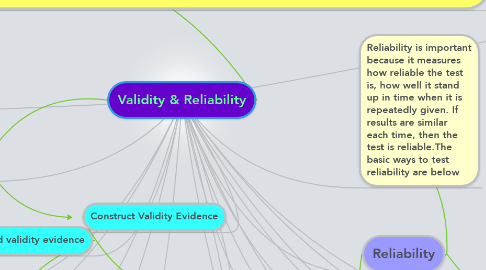Validity & Reliability
by Daphne Butler

1. Validity
2. Validity: Does the test measure what it is supposed to measure? Reliability: Does the test yield the same or similar score rankings (all other factors being equal) consistently?
3. content validity evidence
4. criterion-related validity evidence
5. Concurrent criterion-related validity
6. Predictive validity evidence
7. Construct Validity Evidence
8. content validity evidence is most important because the “job” of an achievement test is to measure how well the content taught has been mastered
9. In concurrent validity evidence, the purpose of a test is to approximate the results that would have been obtained if a well-established test been used
10. provides teachers with the most accurate prediction of future behavior
11. important in establishing the validity of a test when we cannot anchor our test either to a well-established test measuring the same behavior or to any measurable future behavior
12. Validity evidence is important because it measures if a test measures what it is supposed to measure, if it is valid for the intended purpose, and if it does the job it was intended to do.
13. Reliability
14. Test –retest
15. Alternate Forms or Equivalence
16. Internal Consistency
17. Split Halves
18. Kuder –Richardson methods
19. Tests, then retests measures the results a second time to determine reliability
20. Measures an alternate form to compare the scores and determine reliability
21. involves splitting the test into two equivalent halves and determining the correlation between them
22. determine the extent to which the entire test represents a single, fairly consistent measure of a concept.
23. Reliability is important because it measures how reliable the test is, how well it stand up in time when it is repeatedly given. If results are similar each time, then the test is reliable.The basic ways to test reliability are below


